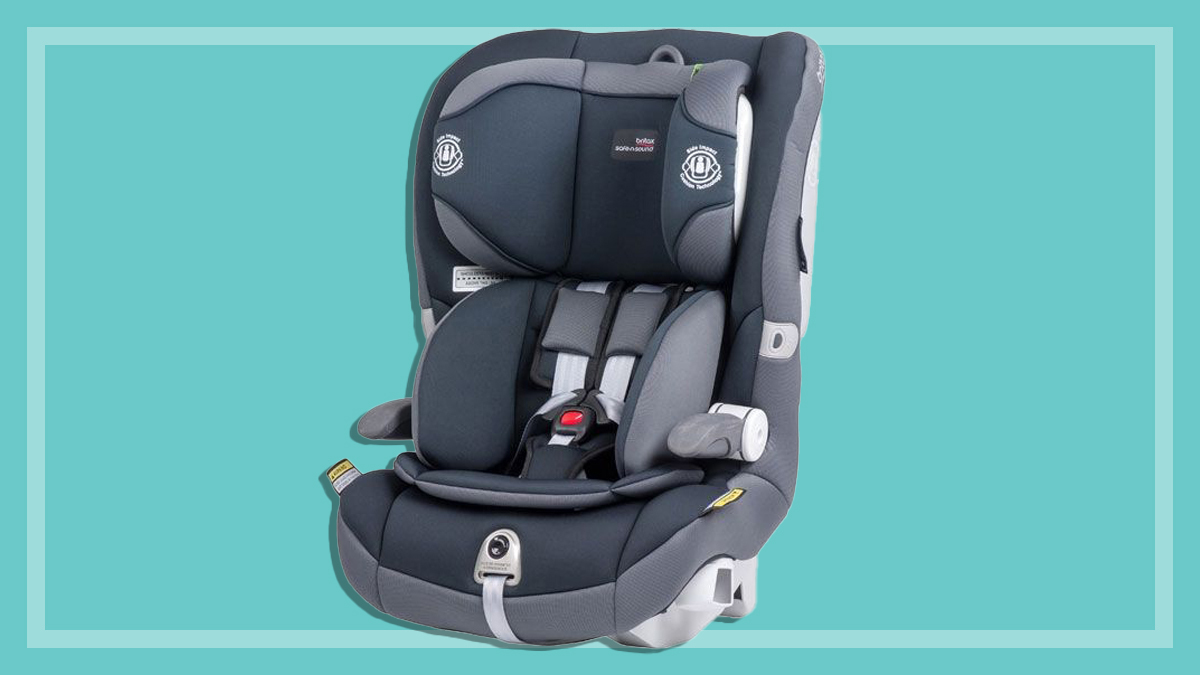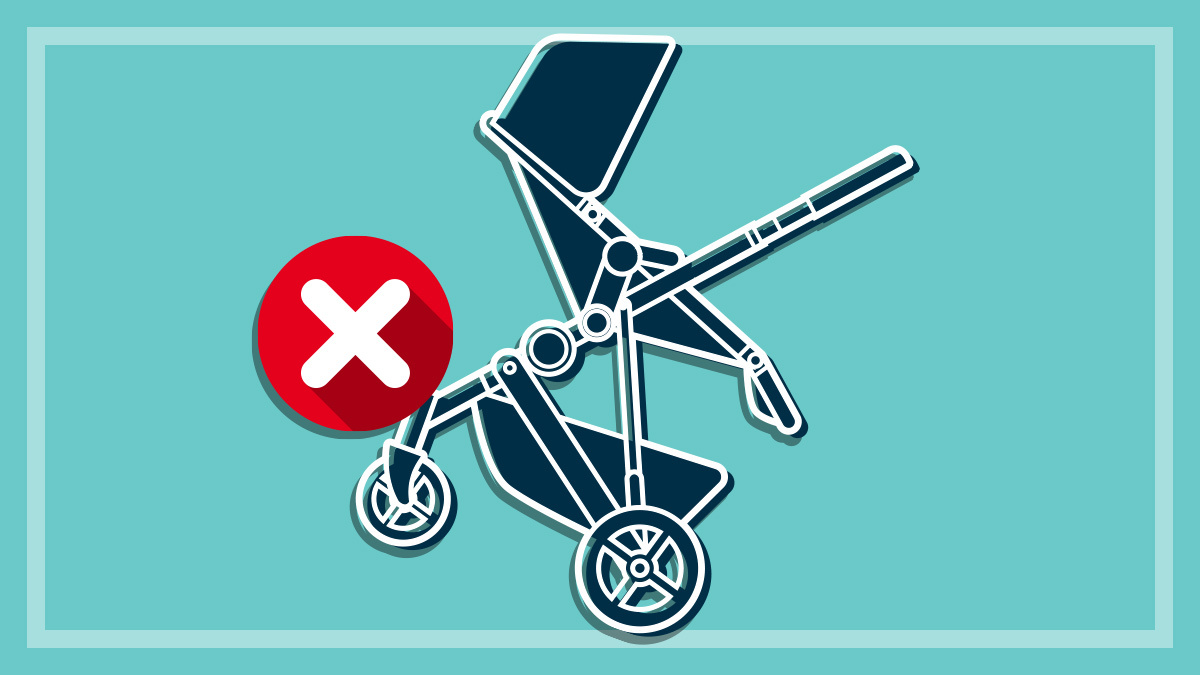Get our independent lab tests, expert reviews and honest advice.
Sugars in packaged toddler foods

When you’re time-poor and caring for a toddler, packaged food from the supermarket can be invaluable. Toss a snack from the pantry into your bag and you can keep your toddler content in the car or placate them in the playground. Home late from work? No problem. Just grab a meal from the freezer to heat quickly and serve.
And not only are they incredibly convenient, but they’re healthy too. At least, that’s what the labels would have us believe, with their claims of ‘locked in goodness’, ‘no added junk’ and ‘made with real fruit’ alongside wholesome images of children and fresh fruit and veg.
But things aren’t always as they seem. We reviewed 78 packaged meals and snacks marketed specifically for toddlers and found that:
- more than half contain sugars that are harmful to health
- many are highly processed
- what’s in the pack often bears little resemblance to what’s promised on the label.
See our analysis below.
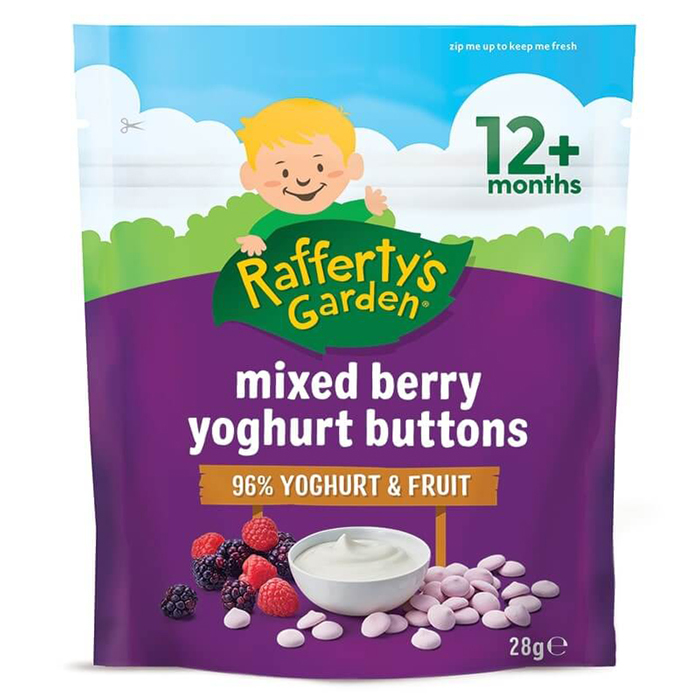
Sugars in toddler food
Most parents would tell you that their children are sweet enough. But manufacturers of toddler foods seem to think otherwise.
Of the products we looked at, 58% contain added sugars that are harmful to health.
Almost half (45%) could be classified as high in sugar, with at least 15g of sugar per 100g.
And the worst offenders are more than 60% sugar.
Toddler foods with most sugar
- Rafferty’s Garden Strawberry Yoghurt Buttons (62.3% sugar)
- Rafferty’s Garden Mixed Berry Yoghurt Buttons (62.9%)
- Kiddylicious Crispy Tiddlers Raspberry (63%)
- Kiddylicious Smoothie Melts Strawberry & Banana (67%)
- Kiddylicious Strawberry Fruit Wriggles (68.8%)
As the toddler snack with the most sugar out of all those we looked at, the Kiddylicious Strawberry Fruit Wriggles was a worthy recipient of a 2021 Shonky Award.
There are several reasons why sugary toddler foods are a concern, not least of which is that having too much sugar in your diet can contribute to health problems.
‘Added sugars’ and ‘free sugars’ are terms that are used to describe sugars that manufacturers add to food. The Obesity Policy Coalition (OPC) wants added sugars clearly defined to include all sugars that are harmful to health – which basically means all sugars other than those naturally occurring in intact fruits and vegetables, and the natural sugars in milk.
This would include the 60-plus different names for sugars that people may not be familiar with, such as dextrose, sucrose, glucose and coconut syrup, and highly processed fruit ingredients including pastes and concentrates.
Health risks to children
Jane Martin, executive manager of the Obesity Policy Coalition (OPC), tells us: “Regularly eating sugary foods puts children at risk of tooth decay and unhealthy weight gain. As they grow older this can lead to increased risk of diseases such as type-2 diabetes, heart disease and some cancers.”
Influencing children’s taste preferences
More insidious is that when children regularly consume sugary foods and drinks, their palates and taste buds adjust in response.
“Children can develop a preference for sweet foods which can result in a diet high in sugar and missed opportunities for the child to develop a taste preference for healthier, unsweetened foods,” says Martin.
Sweet products outnumbered savoury products by almost two to one
Worryingly, sweet products outnumbered savoury products by almost two to one across the 78 toddler foods we found on supermarket shelves.
But avoiding products with harmful sugars and choosing healthier options is far from straightforward. Obstacles include sneaky marketing and weak sugar labelling requirements.
‘Healthy’ labels are often misleading
More than half (54%) of the toddler products we looked at have images of whole fruit on their packaging, but in many instances the ingredients list tells a different story. Often the fruit ingredient is actually a fruit concentrate, paste or puree – used to sweeten the product – and bears little resemblance to the whole fruit from which it’s derived.
“Many snacks marketed for toddlers are sweetened with processed fruit ingredients which are high in sugar,” says Martin. “In a lot of cases, it’s actually sticky, sugary paste, extracted from fruit. This is done by sieving it, boiling it, and removing all its water, until it’s barely more than a pile of sugar.
“Consumption of these products should be limited, but instead manufacturers are trying to dupe families into thinking they’re healthy.”
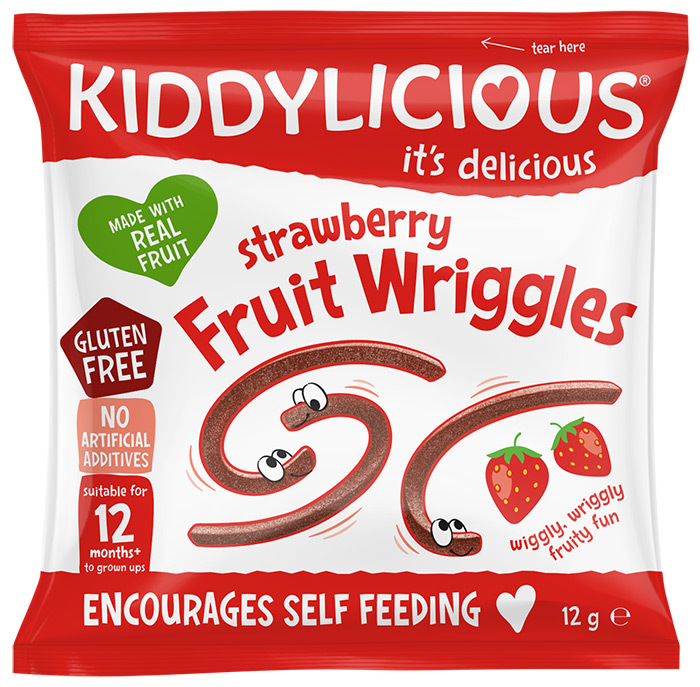
Fruit or concentrated fruit sugar?
Most products that claim ‘made with real fruit’ or purport to contain a certain percentage of fruit on the label – 14% of the products we looked at – are referring to a fruit concentrate or puree rather than whole fruit.
But not everyone has the time (or inclination) when shopping to pore over the ingredients lists. And Martin is concerned that these front-of-pack images and claims can be confusing for caregivers.
“These processed food manufacturers are misleading parents into thinking that these products are healthier than they are, when in fact they are often full of sugar and are packed with cheap sweeteners – shaping our children’s preferences from a very early age,” she says.
Misleading parents
Alice Pryor, Campaigns Manager for Parents’ Voice, is concerned that the availability of these types of products, which are rarely the healthiest choice available, will reinforce the message that toddlers need special food.
“Parents want to give their children the best start to life, and these products lead parents to believe they are healthy and nutritional snacks and meals for their children when the reality is that many of them are actually laden with hidden salt and sugar,” says Pryor.
“The report that 45% of these products are high in sugar is concerning given that most parents of toddlers would struggle to find time in the supermarket to read and compare the small print on the backs of these items.”
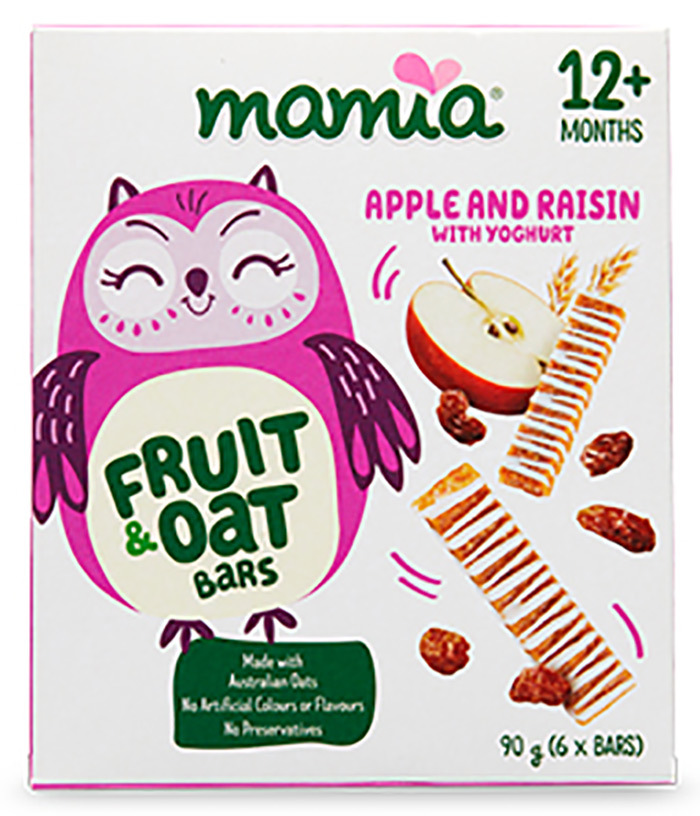
Snacks for healthy development
Another strategy food manufacturers use to market toddler foods is to appeal to a parents’ desire to support the healthy development of their child. This is done at both brand level and product level.
“Our snacking range has been developed to encourage your child to discover new tastes, textures, aromas and shapes,” says the label on Cub brand snacks.
Whole Kids assures us it “is committed to making yummy, nourishing food for your family using real ingredients. No artificial stuff. No funny numbers. And no added junk”.
Mamia (from Aldi) asserts that its food range “has been lovingly developed for your little one to ensure they receive a varied start to their food adventure” and reminds us that “Exploring new textures, aromas and tastes is a vital part of your child’s early development.”
And Rafferty’s Garden Strawberry Yoghurt Buttons are claimed to be “perfect for little mouths” while Only Organic Yoghurt Rice Cakes are “the perfect size and shape for little hands to hold”.
Alternatively, you can simply head to the fruit department and find plenty of in-season fruits that tick all of those boxes.
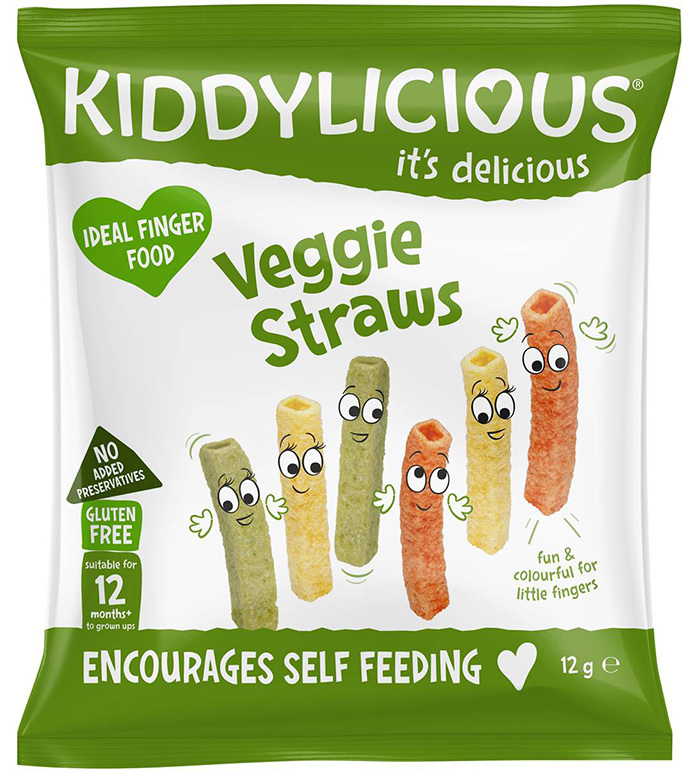
Highly processed, no substance
Sometimes the problem with packaged toddler foods isn’t just about what’s in them – such as harmful sugars – but also what’s not in them.
Kiddylicious Veggie Straws, for example – which are essentially puffed-up potato starch, with added veggie powders, salt and oil – have minimal added baddies, it’s true. But the point is they’re so highly processed they offer little in the way of nutritional value – just empty kilojoules.
They’re also reminiscent of mainstream snack products such as Burger Rings and Cheetos, a similar look and feel that isn’t ideal if it leads to a taste and preference for those types of snack foods.
Better sugar labelling still needed
At the moment, it’s difficult to decipher how much sugar has been added to a food by looking at the label.
Added sugars can be disguised by going under more than 60 different names, some of which are perhaps more familiar (cane sugar or treacle, for example) than others (such as maltodextrin, corn syrup or fruit juice concentrate).
As they aren’t grouped together in the ingredients list, they’re not always easy to identify. And the total sugar listed in the nutrition information panel doesn’t differentiate sugars that have been added by the manufacturer from those that are intrinsic to the food or one of its ingredients. This makes added sugars even harder to quantify.
CHOICE has long lobbied for clear and meaningful added sugar labelling on foods, so that consumers can make informed decisions about the products they buy.
The OPC is advocating for improvements too, urging food ministers to implement higher standards and make added sugar labelling mandatory.
Crucially, Martin explains, “We want to see added sugars clearly defined to capture all sugars that are harmful to health, including highly processed fruit ingredients like pastes and concentrates which are often in products marketed as healthy, such as toddler foods.”
Sugar coating
More than 60 different names for ‘added sugar’
Agave nectar/syrup
Barbados sugar
Barley malt extract/syrup
Beet sugar
Blackstrap molasses
Brown sugar
Cane juice/juice crystals
Cane sugar
Caramel
Carob syrup
Caster sugar
Coconut sugar
Coffee sugar crystals
Confectioner’s sugar
Corn syrup
Crystalline fructose
Date sugar/syrup
Demerara sugar
Dextrin
Dextrose
Florida crystals
Fructose
Fruit juice/juice concentrate
Fruit paste
Fruit powder
Fruit puree
Glucose/glucose syrup
Golden sugar
Golden syrup
Grape sugar/syrup
High fructose corn syrup (HFCS)
Honey
Icing sugar
Invert sugar
Jam
Lactose
Malt extract/syrup
Maltodextrin
Maltose
Maple syrup
Molasses
Muscovado
Nectar
Oat syrup
Palm sugar
Panela
Panocha
Rapadura
Raw sugar
Refiner’s syrup
Rice malt extract/syrup
Sorghum syrup
Sucanat
Sucrose
Sugar
Syrup
Treacle
Turbinado
Vegetable juice/juice concentrate
White sugar
‘No substitute for whole fruit’
Pryor would also like to see more truth in labelling. “Fruit concentrates, pastes and purees are added sugar and no substitute for whole fruit,” she says.
“Companies should not be associating these products with whole fruits, and should display clearer front-of-pack labelling for busy parents.”
Currently there’s some regulation around foods for infants, including sodium limits, but not for toddlers, or relating to sugar content.
“Most parents would be surprised to hear that there is no regulation of toddler foods,” says Pryor. “Governments should set a better standard and regulate the contents of foods formulated for toddlers.”
Martin agrees: “We also want the government to regulate the amount of added sugar that food companies can put in infant and toddler foods to protect the health of our youngest Australians.”
How to be snack savvy
Nutritious, whole foods that are simple to prepare make the best snacks – fresh fruit pieces, veggie sticks, cheese cubes, plain yoghurt or wholemeal toast fingers, for example.
Toddlers don’t need special foods, they can eat the same healthy food as the whole family
Jane Martin, executive manager of the Obesity Policy Coalition
“When shopping for foods for toddlers, look for the healthy whole foods which tend to be located around the outside of the supermarket,” says Martin.
“Most processed packaged foods including those for toddlers tend to be in the aisles.”
Four top tips
But there’s no doubting the convenience of a packaged snack. So if you do decide to buy one, follow these tips to make an informed choice:
- Read the ingredients list first – ingredients are listed in order of greatest to smallest quantities. As a rule of thumb, the shorter the list, the better. Aim for products with a small ingredients list consisting of whole foods and no added sugars and salt.
- Check for real fruit ingredients, not just fruit concentrates, pastes, purees and powders.
- Don’t be swayed by marketing claims that the snack will “encourage self feeding” or is “easy to grasp with little fingers”. A cucumber stick, a crust of wholemeal bread, a rice cracker or a banana can all do the same job.
- Consider all packaged snacks to be ‘sometimes’ foods, not regular staples.
Finally, think twice before heading to the baby and toddler food section of the supermarket. You can often find a healthier – or at least cheaper – snack if you choose from a different aisle. See our examples below.
Snack swaps
Veggie snacks
Toddler snack: Kiddylicious Sour Cream & Chive Flavour Veggie Straws (Price/100g: $12)
They may be ‘easy to grasp’ and in a format that ‘encourages self feeding’ but they’re still flavoured, puffed-up snacks that offer little nutritional value.
Alternative snack: Cobs Sour Cream & Chives Corn Puffs (Price/100g: $2.92)
Also a flavoured, puffed-up snack, but without the extra plastic and price mark up of a multipack. Why spend more than you need to?
Best snack: Baby Corn spears (Price/100g: $0.24)
High in fibre, naturally sweet and just as easy as a ‘veggie straw’ for toddlers to grasp.
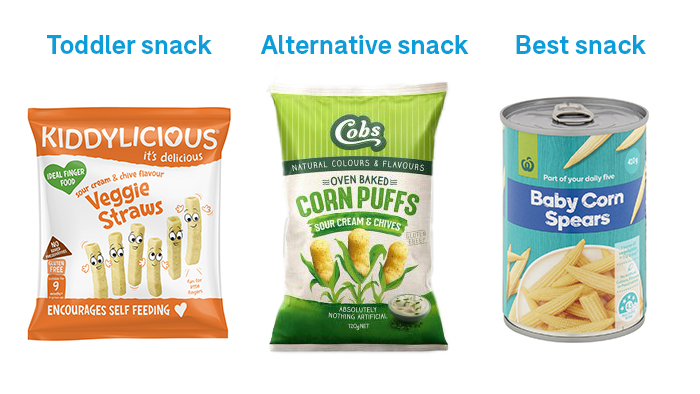
Rice snacks
Toddler snack: Little Quacker Rice Biscuits Strawberry Flavour (Price/100g: $7.50)
Made from organic sugar (and rice), but their ‘organic-ness’ doesn’t mean they’re nutritious. Plus you’re paying a premium for a product that’s ‘conveniently wrapped in packs of 2’.
Alternative snack: Sakata Stars Plain Rice Crackers (Price/100g: $3.85)
Still in convenient snack packs but about half the price, and without the added sugar.
Best snack: Ceres Organic Brown Rice Crackers (Price/100g: $2.70)
Brown rice means more fibre, and these crackers don’t come with the price hike (or extra packaging waste) associated with individually wrapped servings.
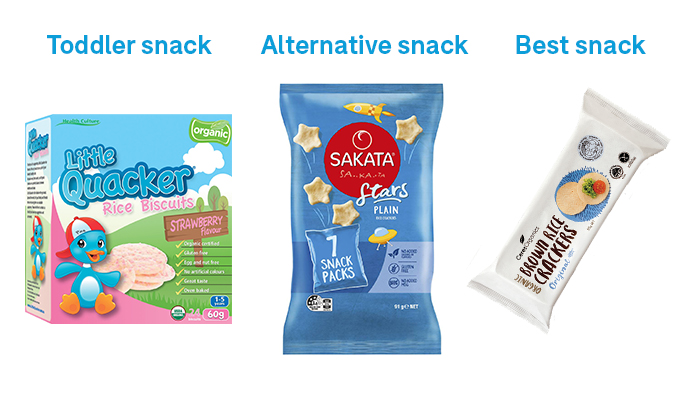
Apple snacks
Toddler snack: Kiddylicious Strawberry Fruit Wriggles (Price/100g: $15)
These Shonky Award-winning ‘Fruit Wriggles’ are 74% apple puree and juice concentrate, and 24% strawberry puree – and almost 70% sugars overall.
Alternative snack: Angas Park Dried Apples (Price/100g: $2.20)
Dried apple slices are a fraction of the cost, and you get the benefit of fibre, among other nutrients that are lacking in the Fruit Wriggles.
Best snack: Apples (Price/100g: $0.39)
A perfectly delicious, nutritious fruit packaged by nature. Cut into wedges or ring slices for little hands.
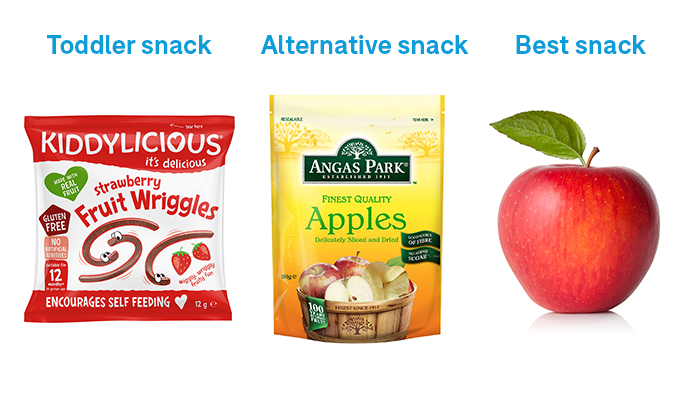
Yoghurt snacks
Toddler snack: Rafferty’s Garden Strawberry Yoghurt Buttons (Price/100g: $15.71)
These snacks are 97% ‘yoghurt’, but the second biggest ingredient of the yoghurt is sugar, resulting in a product that’s more than 60% sugar overall.
Alternative snack: Farmers Union Greek Style Yoghurt With A Hint Of Real Strawberry (Price/100g: $1.15)
In a squeezy pack that appeals to toddlers, you get the benefit of protein and calcium from yoghurt in this form. It’s lower in sugars (just over 10%) but is still sweetened (with strawberry puree and reconstituted juice).
Best snack: Farmers Union Greek Style All Natural Yoghurt (Price/100g: $0.55)
Made from milk and live cultures, natural yoghurt is a good source of protein and calcium, and the only sugars present are those naturally found in milk. If you want to sweeten it yourself, simply add some chopped fresh fruit.
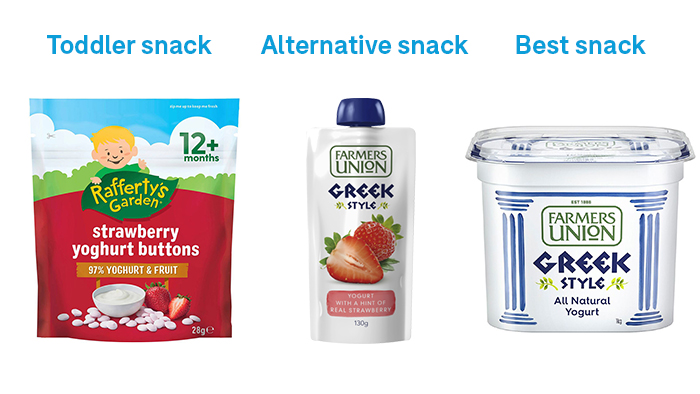
Grain snacks
Toddler snack: Whole Kids Organic Farm Animal Biscuits (Price/100g: $3.43)
These are lower in sugar than many commercial biscuits, but they’re still 22.7% sugars. The cane sugar and other ingredients are organic, but there’s nothing healthy about organic sugar or organic cornflour.
Alternative snack: Arnott’s Shredded Wheatmeal Biscuits (Price/100g: $0.92)
Arguably less fun than biting the ears off a rabbit or the snout off a pig, but certainly cheaper. These biscuits also have less sugar (16.8%) and higher fibre from their wheatmeal ingredient.
Best snack: Wholemeal toast fingers (Price/100g: about $0.30-$0.40)
High in fibre, free of added sugar, and tasty. Just add sliced banana for natural sweetness!
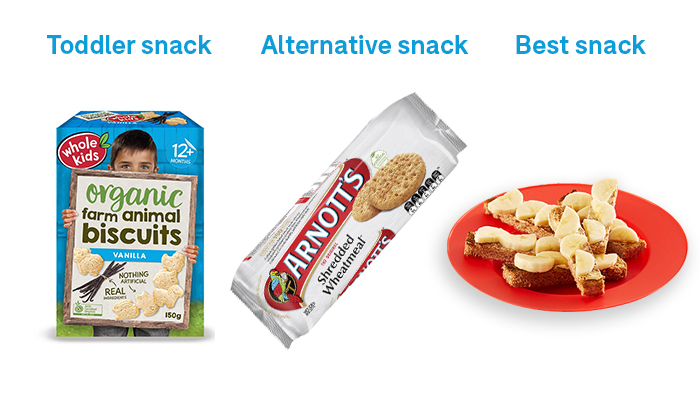
Our analysis
In 2019 the OPC published the results of its analysis of food products marketed for infants (babies under 12 months) and toddlers (aged 12 to 36 months), excluding formula, available from Aldi, Coles and Woolworths. For the current review, CHOICE updated and expanded on the original data to reflect packaged toddler food products available in 2021.
We’ve focused on products in the baby-food aisle and freezer section (not the snack food or chiller aisles) and labelled specifically as being for children aged 12 months and above. Details we recorded include brand, price, nutrition information, ingredients list, pack claims and pack imagery.
Packaged toddler food overview
- 78 products reviewed, from 15 different brands
- 73% were snacks (puffs, bars, biscuits, cakes, straws, buttons etc), 17% meals, 10% fruit and veg
- 63% sweet, 37% savoury.
Our thanks go to the OPC for kindly giving us access to the original dataset.



